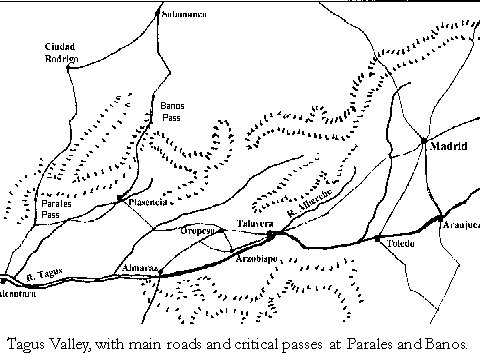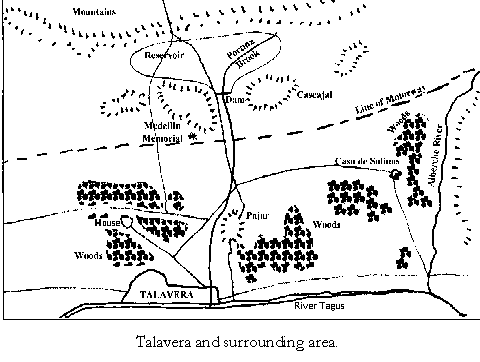
In Madrid, Napoleon's elder brother Joseph, king of Spain by the grace of French bayonets, was in a quandary. News of Soult's expulsion from northern Portugal on the 18th May had alerted himself and his military adviser, Marshal Jourdan, to Victor's danger and they had ordered his withdrawal out of harm's way. What else could be done to counter the allied moves?
The French calculated that the combined armies of Wellesley and Cuesta
would total some 100,000 men.[5] In fact
they were closer to 55,000. This was made up of 35,000 Spanish and 20,000 British, the Portuguese contingent having been
left behind under Beresford to guard Portugal. To respond to this threat Joseph had French corps of varying sizes scattered about central Spain. Victor with 20,000 men was based around Talavera, 70 miles Southwest of Madrid. General Sebastiani was at Madridejos, south-east
of Madrid with another 22,000. In addition there were 12,000 men in the capital itself. A plan was conceived [6] whereby Sebastiani would move through
Toledo to Talavera where he would join forces with Victor. The king and his adviser with most of their troops would then march from Madrid and complete the concentration of French forces in central Spain.
Soult's problem was that his troops were in a sorry state after their expulsion from Portugal. Equipment, transport and artillery had all been lost; they needed time to recover and re-equip; time which Wellesley's original plans had been designed not to let them have. After some indecision on Joseph's part, the orders were issued and the French army's concentration began. Joseph and Jourdan left Madrid on 23rd July.
The allies, meanwhile, were having their own troubles deciding what to do now that the opportunity to catch Victor had been lost. Wellesley rode ahead of his army on the 10th July to meet with Cuesta at Almaraz. Due to bad maps and an even worse guide, the meeting was
delayed by five hours. A review of the Spanish troops took place by torchlight. Even in the dim light Wellesley could see their poor quality. The men themselves were of good standing but arms and equipment were old and in bad repair. More significantly, they could not drill properly. If they could not drill, then manoeuvring in the face of the enemy would be courting disaster. The officers were no better than the men, unprofessional if not incompetent.
Using interpreters and their own halting French the leaders talked and argued through the
dark hours. Cuesta's contribution consisted mainly of 'Non!' to Wellesley's suggestions. His Adjutant General O'Donoju was more amenable, 'I settled the plan of operations with General O'Donoju who appears to me to be a very able officer,... It is impossible for me to say what
plans General Cuesta entertains.' Wellesley to Frere, 13 July. [7]
The joint army of 55,000 men was to advance on Victor's corps of 20,000 men around Talavera. With luck he still might be caught before the French combined their forces. A vital part of the plan was for another Spanish army under General Venegas consisting of 30,000 men in the mountains south of the Sebastiani force to move on Madrid. This should pin Sebastiani in place or if he did move allow Venegas to march into the capital; the political consequences of which would be immense.
Sir Robert Wilson with a small force of less than 2,000 men would perform a similar function to the north-west of Madrid. In the event Venegas was blocked by a small force at Toledo and neither held Sebastiani nor seriously threatened Madrid. Wilson achieved more with less, confusing the French mightily.
As a final precaution against any interference from Soult's forces regrouping to the north, Beresford was instructed to defend the pass of Perales. Cuesta was requested to guard that of Banos. Both these passes would allow Soult to march on Wellesley' s left flank as
he moved eastwards up the valley of the Tagus. French plans had been anticipated and steps taken to counter them, however the poor execution of those counter moves would put Wellesley's army in a potentially dangerous position.
The allied armies met at Oropesa on the 21st July and continued to move towards Talavera. Next day the leading Spanish cavalry units met French dragoons and some artillery at Gamonal. Despite outnumbering the French the Spanish cavalry could make no headway even assisted by their infantry. When Anson's German and British horses moved on their nght the French quickly
withdrew east of Talavera and over the Alberche, a small river that flows into the Tagus. Victor had the rest of his force arranged on its eastern bank. By late evening the British were in position on the hills opposite the French right.
Wellesley had his army under arms by 2.00 a.m. and manoeuvred them into position by 3.00 a.m. He only awaited the Spanish attack that would be the signal for his own thrust. No sign of movement came from Cuesta's army. Wellesley wrapped himself in a cloak and went to sleep. Daylight arrived but still no attack. Finally Wellesley rode over to Cuesta only to find the old gentleman asleep. His army had been marching for two days and needed a rest, they would attack the following day. However the next day there was no one to attack, Victor had withdrawn
again, another opportunity missed.
Now that it was too late Cuesta was eager to advance and catch Victor. What had prompted this sudden burst of energy? He had learned that the Supreme Junta had told Venegas that he would be Commander-in-Chief of all Spanish armies if he took Madrid. Cuesta wanted that
post for himself and so he was determined to push on and take Madrid before Vengas got there. Had he but known that Vengas was fruitlessly counter-marching between Toledo and Aranjuez, he could have rested another day.
This time Wellesley refused to advance. Perhaps his patience with his fickle ally was wearing thin, besides, he was hearing rumours of Joseph's and Jourdan's move towards Victor. Another factor was the lack of supplies. The Spanish had promised to supply his army but so far
precious little had been forthcoming. He wrote complaining to Frere on July 24th, 'This is a rich country in corn, in comparison with Portugal...The Spanish army has plenty of
everything, and we alone, upon whom everything depends, are actually starving.'
[8]
Serious consideration was given to a withdrawal from Spain, but he eventually decided to stay. Cuesta moved off after the French without the British on the 24th and was soon well on the way to Toledo. The prize of Madrid and command of all Spanish armies glittered before him.
Fortunately for the aged general on the 25th he learnt that Joseph and Jourdan were marching from Madrid and that Sebastiani's force had joined Victor. He was outnumbered and without the British to support him in danger of being destroyed. He quickly retraced his steps,
chased and harried by the French, back to the protection of the British army.
Back to Table of Contents -- First Empire 26 This article appears in MagWeb (Magazine Web) on the Internet World Wide Web. Leaving garrisons in the capital and Toledo would give the French a striking force of 50,000 men, most of them good quality troops with battle experience. The key to French success would be a move by Soult's force down from his new base at Zamora to Plasencia. There he could cut
Wellesley's communications with Portugal and block his line of retreat.
Leaving garrisons in the capital and Toledo would give the French a striking force of 50,000 men, most of them good quality troops with battle experience. The key to French success would be a move by Soult's force down from his new base at Zamora to Plasencia. There he could cut
Wellesley's communications with Portugal and block his line of retreat.
 The Spanish had moved through Talavera and faced the French left over the Alberche which was fordable and was crossed by a bridge at this point. Agreement was reached for Cuesta to attack across the river next morning while the British moved down from the north and attacked the French flank.
The Spanish had moved through Talavera and faced the French left over the Alberche which was fordable and was crossed by a bridge at this point. Agreement was reached for Cuesta to attack across the river next morning while the British moved down from the north and attacked the French flank.
© Copyright 1996 by First Empire.
Other military history articles and gaming articles are available at http://www.magweb.com